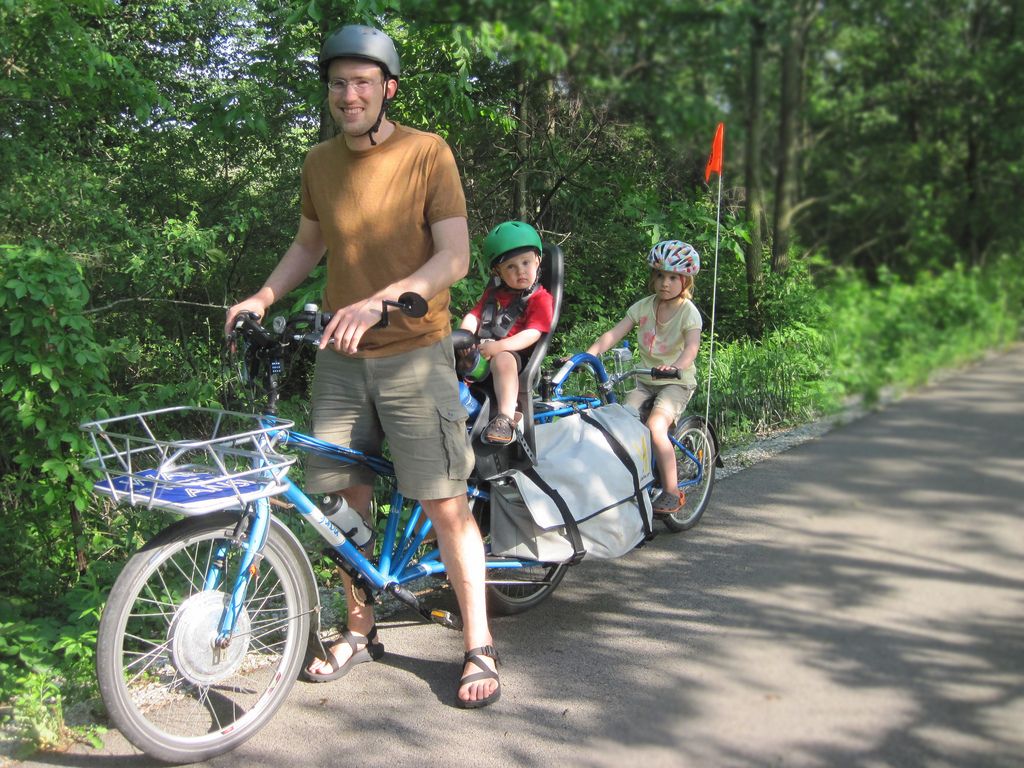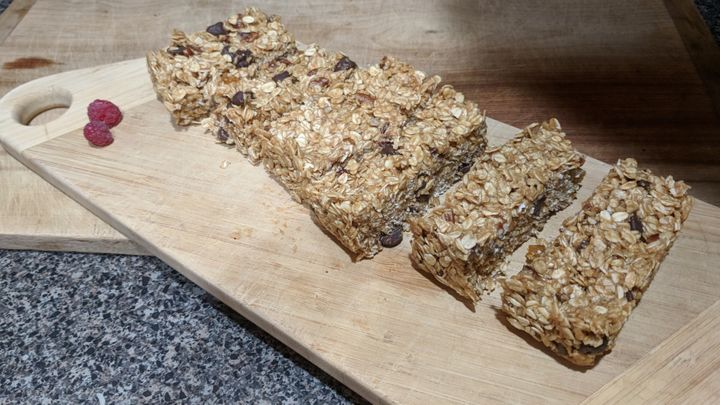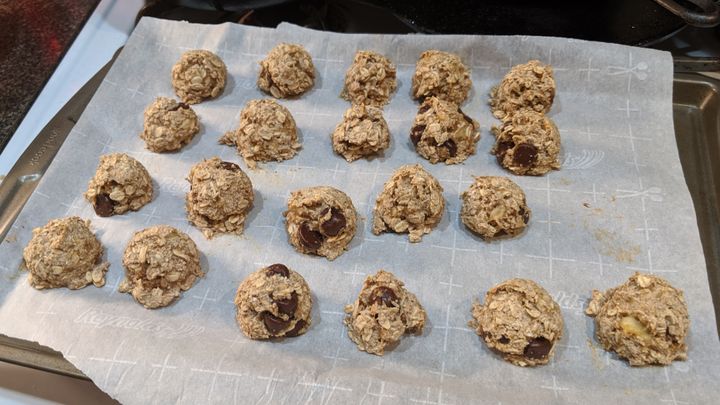Building and Maintaining Back Health

I would not have been able to enjoy my recent bike camping trip if I hadn’t improved my back health. When my back health was worse, sleeping on a mat in tent each night made it worse. Multiple days of tent camping would only compound the problem.
Here’s my story of how I got bad sciatica then recovered and made some changes to keep my back healthy in the future.
My journey to recovery is also covered in this episode of the Glen Merzer Show podcast:
Using a recumbent bike for sciatica recovery
At age 28 I was giving an impromptu juggling show for a neighbor’s child. I bent over to throw a ball underneath my leg and something in my back shifted, starting unbearable pain. I soon excused myself and spent much of the next week flat on my back.
I was diagnosed with a herniated disk in my lower back. My sciatic nerve was pinched in my lower back. There was pain down one or both legs when I stood up. I had sciatica.
I spent a week lying on my back and having instant meals, because it hurt too much to stand long enough to prepare anything but the most simple meal. Going into the second week, I was desperate for some return to normalcy and tried an experiment. I hobbled out the bike shed to see how painful it would be to ride my Rans V-Rex, a recumbent bike. (I would later trade it in for the Surly Big Dummy I ride now). The seat was more reclined than most seats, so it might be feel more like lying down than sitting. That could make it low pain.
I pulled out of the alley and was tentative with the first strokes. Even if there wasn’t immediate pain, I was concerned that some shooting pains might appear while I was riding, causing a wreck or leaving me stranded waiting for someone to pick me up.
But so far my experiment worked. I began to pedal harder and harder, until I was going full steam. There was no pain! It was working. I took an easy ride of a mile to the library, feeling good while I was on the bike. I had to move around the library quickly, as the pain was building quickly as I checked out some books on Sciatica. The irony.
The pain was significant by the time I returned to the bike for the return trip. Again, I took off with some concern– I had made it here, but perhaps there would be a problem on the return trip, having started with some pain getting on the bike.
But again, I was able to pedal trouble free. Since I was on “vacation” that week, I started taking longer and longer bike rides each day. I practiced a 25 mile loop and that went well– I rode the course at full speed with no problems.
The experience allowed me to get my blood flowing, clear my head, get some fresh air…feel normal. There wasn’t immediate relief when the ride was over, but I knew this helping my recovery. Certainly my mental state and outlook improved.
The irony was that even by the time I parked the bike in the bike shed, I would already start having pain off the bike again as I rushed to the house to lie down again.
I took a risk and decided to set a daily distance record in this condition– I planned a 60 mile solo round trip ride from Richmond, Indiana to Oxford, Ohio and back.
As I pedaled down the barren country roads on the way there, I had doubts the trip I was embarking was a good idea. I arrived in Oxford safely but still had to sit on floor of bike shop briefly while I shopped there. I couldn’t stand comfortably long enough to complete the task.
Even on the way back, the pain on the bike did not increase, although I approached being on the bike about four hours that way.
Over the next few weeks, the pain eventually tapered off without the need for surgery or other expensive treatment. Besides cycling, I also used walking, massage, acupuncture and gentle yoga to help recover.
I would definitely recommend trying some form of cycling to others recovering from sciatica or lower back pain. Some stationary bikes are also recumbent, and may be available at local gyms or health clubs. I hope you will be surprised like I was to find that cycling can be comfortable even when other positions are not!
Building and maintaining a healthy back
I’ve since learned that my sciatica had much less to do with that ball I threw under my leg and much more to do with how I was treating my back before that and the signals that I was ignoring: the stressful year at work which was peaking; year upon year of sitting at a desk job.
I tried everything I could think of to get better: acupuncture, chiropractics, yoga, massage, reading about sciatica.
My immediate concern was how to resume doing the computer work that paid the bills. The first week I worked laying flat on my back. The keyboard was on my lap (where I couldn’t see it) and the laptop rested open up on it’s side next to me, so I could tilt my head to side to read it.
I tried heating pads, ice packs and tennis balls in my desk chair. They all helped, but I tired of each of them, so I used them in rotation.
I slowly got better over several weeks, and tried to watch for early signs of problems returning.
But seven years later at age 35 I got sciatica again. This time the pain was mild enough not to interrupt my employment, but was still frustrating. I went back to a different chiropractor who X-rayed me. He showed me a picture of myself as a skeleton, already looking dead. He pointed to my spine and claimed I had irreversible and permanent degeneration. My best course of action would to be to immediately sign up for a block of appointments and plan to manage the problem for the rest of my life. I fired him.
Now at age 40 my back health is better than it’s ever been. I can sit on a couch or in a church pew without discomfort. I no longer believe I need to replace my mattress. The spare futon that I found intolerable to sleep on is now enjoyable. And I can get a good night’s sleep in a tent, night after night.
To get my back health back in order, I made changes to build a back that is stronger, more flexible and lighter. I rejected the idea that I had a “bad back.” I accepted that I had unhealthy back that needed make some permanent changes to my daily life.
Here at the changes I made.
I ended the decade of sitting in a chair. Fewer back muscles are needed to support the back when sitting in a chair, so the muscles weaken. With the legs bent, there’s also more tension as the legs connect with the lower back. There was also the simple fact that sometimes it was more comfortable to stand, especially when I was recovering from a lower back problem.
At work I got a sit/stand Geekdesk so I could work standing up as much as wanted. A cheap sit/stand desk alternative is just to have standing height desk, with a stool or drafting height chair for sitting. At home I converted half a closet into a standing desk. I had young children with less time for computer work at home, so I didn’t even bother with a sitting option.


When I wanted to sit down at work, I got a fitness ball. There’s no back to a fitness ball, so lower back muscles strengthen to hold up the back. Also, the angle of the legs can be more open, reducing muscle tension. The natural fidgeting that happens on a fitness ball helps to strengthen core back muscles.
In my early stages of recovery, I rotated between the old office chair, standing and the ball throughout the day, as each would become uncomfortable after a period.
Eventually my core back muscles grew and adapted to the point where it was comfortable to use the fitness ball all day. Now I haven’t used a chair for desk work in over a year, most of the time I use a fitness ball with some standing.
Research shows mixed results for the benefits of sitting on a fitness ball. I recommend trying it if you seem prone to lower back pain or sciatica. It’s been a big part of my long term recovery.
When I moved into my current house about three years ago, I got a GeekDesk sit/stand desk for my home office, and another fitness ball for sitting at my computer at home.
Besides changing how I sit, two years ago at age 38 I started running regularly. There have been many benefits: I lost over 20 pounds and have kept the weight off, so my back is lighter. Running provides help provide stress relief. The latest research says the “runners high” from long runs comes from endocannabinoids, chemicals that— like the cannabinoids in marijuana— lighten mood. My core is more flexible simply from getting loosened up on a more regular basis. Running also helps to strengthen the core back muscles.
I started with two mile runs, then three, four, five and six miles. One weekend a meandering run turned into eight miles. The next weekend on early but hot July morning I tried and completed my first ever 13.1 mile run. It was tough and slow at the end.
Now I average 20 to 25 miles week of running. Much the mileage comes from replacing two 6-mile round trip bike commutes each week with run commutes. I try to get a longer run in on a weekend morning to round out the week. Two years later I’ve completed four half marathon events, two trail marathons and one 50k (31 mile) trail event.
I noticed though the more I ran, I the less I stood at my desk instead of using the fitness ball. It’s nice to sit after running three or more miles to work.
I still appreciate chiropractics, massage and acupuncture but rarely feel like I need to take advantage of these services. I don’t keep up with yoga like perhaps I should (read: I barely practice), but I try to do some dynamic stretching before I run and some static stretches when I finish, which is better than the complete lack of stretching I was doing before I started running.
The chiropractor was right: I did need to make some permanent changes for the benefit of my back. I’m glad I was able to find another path besides a lifetime’s worth of medical appointments to help mine.
Camping Mats for Sensitive Backs
I tried different options for sleeping mats to find one that allow me to have a good nights sleep while camping and not aggravate my back.
I’ve been pleased to find that recently there are no-compromise sleeping pads available for bike touring. You can find options that are lightweight, pack small and yet provide great comfort as well.
The one I used successfully on our last tour is the NeoAir Trekker. While the exact model will get outdated, this type of sleeping mat will remain: It’s an inflatable mat that inflates to 2.5″ high.
To minimize pressure on my back I inflate the mat all the way and then slowly let out air while lying on it. I stop letting the air out when my lowest point is just a millimeter or two off the ground, creating a mild hammock effect.
My wife had been using a class self-inflating Therm-a-Rest, but also quickly became a convert to these thicker inflatable pads once she tried them.
My one wish to improve the pad would be that it could inflate even faster, to save a minutes at the end of day of bike touring. If a single person in charge of setting up the tent, the time can be multiplied.
Cascade Designs has already released such an update with the NeoAir Trekker SV, which uses a new “speed valve” design that is 2 to 3 times faster to inflate.
If you can get an to outdoors store where you can try out several mats. If you can’t, I heartily recommend the NeoAir line.
Camping pillow or not?
My wife and I took different approaches to camping pillows.
I decided not to bring one in the spirit of minimalism and after several failed attempts to use one on previous trips. I had tried a simple nylon inflatable pillow. The inflatable pillow concept didn’t work for me. It wasn’t soft. Also, the nylon of the pillow would reliably slip against the nylon of the mat during night, I would wake up without the pillow.
Instead, I used the small stuff sack that had some spare clothing in it. I adjusted the clothing inside to a good-enough pillow shape. Then I had one less thing to pack.
My wife chose a more plush camping pillow, the “Cocoon Air-Core Hyperlite Pillow.” It was larger, softer and less slippery than mine. It was still inflatable but had a layer of polyester fill. She liked it and stuck with it. It still packs very small and weighs about 2.4 oz, a pittance.
As with sleeping pads, there’s no substitute for trying out camping pillows if you can. If you want to try one, avoiding the “slick, inflatable balloon” style that failed me. Consider one that includes a little polyester fill and soft surface.



Comments ()